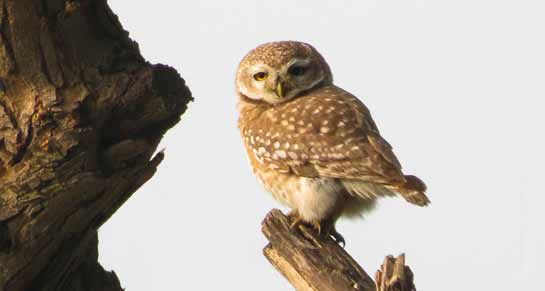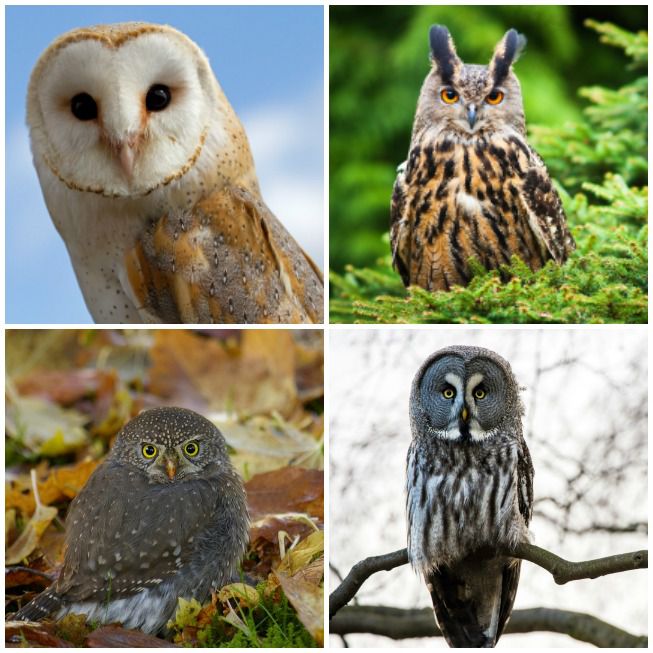Owls are rather unusual in the bird kingdom. They have huge eyes that are fixed in their sockets, and feathers that help form flatter, more rounded faces than other bird species — faces that we humans can’t seem to resist. So, we’re going to indulge ourselves. Meet 18 owls with an abundance of cuteness and attitude.
Snowy owl
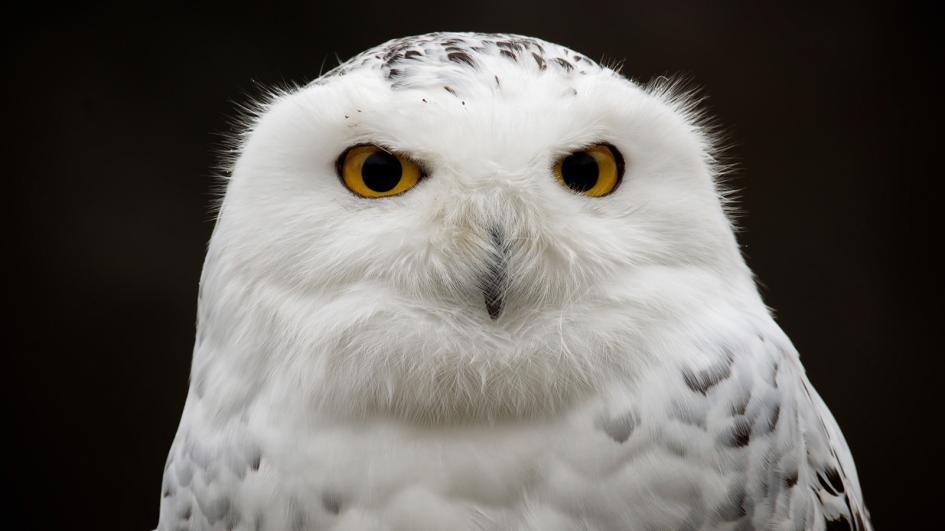
These large owls mainly live in the Arctic in open, treeless areas called tundra. Snowy owls perch on the ground or on short posts. From there they patiently watch for prey. Their favorite target is lemmings—small mouselike rodents—but they also hunt for other small rodents, rabbits, birds, and fish.
Long-eared owl
 The long-eared owl is a bit of a squatter as it prefers to take over other birds’ abandoned nests.
The long-eared owl is a bit of a squatter as it prefers to take over other birds’ abandoned nests.
Found in North America, Europe and Asia, the long-eared owl takes up residence in the abandoned nests of similarly sized birds such as hawks, ravens or magpies.
Barn owl
 There are more than 22 different barn owl species.
There are more than 22 different barn owl species.
That heart-shaped face is characteristic of barn owls. This species is not only the most widespread owl species, but also one of the most widespread of any bird species. So it is no wonder that it has more than 22 other names, including ghost owl, death owl, hissing owl and delicate owl.
Spectacled owl
 This rain forest-dwelling owl isn’t afraid to take on prey larger than itself.
This rain forest-dwelling owl isn’t afraid to take on prey larger than itself.
A resident of southern Mexico, Central America and parts of South America, the spectacled owl prefers living in dense, old-growth rain forests. It preys on small mammals that are active at night, though it can take down prey larger than itself, including a three-toed sloth.
Oriental bay owl
 The Oriental Bay owl favors hollows trees and stumps for its nests.
The Oriental Bay owl favors hollows trees and stumps for its nests.
This unusual looking owl can be found throughout Southeast Asia. It is part of the barn owl family, one of two families of owl, the other being “typical” or “true” owls.
Eastern screech owl
 Despite its name, this owl doesn’t screech all that often.
Despite its name, this owl doesn’t screech all that often.
Found throughout eastern North America from Canada to Mexico, this short and stocky species has a misleading name. It doesn’t actually screech, but makes a descending tremolo call. Still, it is usually heard rather than seen.
Snowy owl
 The snowy owl is a heavy bird, but flies swiftly.
The snowy owl is a heavy bird, but flies swiftly.
While it is primarily found in the Arctic tundra of North America, Europe and Asia, these snowy-speckled birds will sometimes visit the Eastern Seaboard of the United States. It is one of the largest owl species, and it is the heaviest.
Eurasian eagle owl
 The Eurasian eagle owl will eat just about anything.
The Eurasian eagle owl will eat just about anything.
Also one of the largest owl species, the Eurasian eagle owl is larger than the snowy owl, with a wingspan of 5 to 6 feet. A powerful predator, it is not a picky eater, consuming everything from small mammals to snakes and other reptiles, and even larger prey like foxes or similarly sized birds like geese and other owl species.
Tawny owl
 Tawny owls rely heavily on their vision and excellent hearing to pinpoint prey.
Tawny owls rely heavily on their vision and excellent hearing to pinpoint prey.
The tawny owl is one of the most common owls in England, but it is rarely seen due its nocturnal nature.
Great gray owl
 This great gray owl is deceptive in its size.
This great gray owl is deceptive in its size.
Though it is believed to be the world’s largest owl (it’s the longest, but not heaviest) much of that size is deceptive. Its fluffy feathers and long tail belie a small, light body.
Great horned owl
 The great horned owl is one of the most recognizable owls in the United States.
The great horned owl is one of the most recognizable owls in the United States.
There is a reason that this is the species used as a model for statues of owls strategically placed on buildings and in yards to keep smaller birds away. Author Carol Lee points out that, “Almost any living creature that walks, crawls, flies, or swims, except the large mammals, is the great horned owl’s legitimate prey.” It is one of the most widespread and adaptable owls in the Americas.
Northern pygmy owl
 The tiny northern pygmy owl likes the early morning and the early evening.
The tiny northern pygmy owl likes the early morning and the early evening.
We’ve heard about the larger owls but what about the tiny species? The northern pygmy owl is a mere 6 inches long. Unlike many owl species, this one is diurnal and also active at dawn and dusk.
Burrowing owls
 As their name suggests, burrowing owls live in holes in the ground, not trees.
As their name suggests, burrowing owls live in holes in the ground, not trees.
Not all owls live in trees, as the burrowing owl can attest. This species takes up residence in old ground squirrel or prairie dog burrows. Hunting at night, it can fly as well as use its long legs to sprint and capture prey.
Northern saw-whet owl
 Even though it’s small, its hoot sounds like a saw being sharpened.
Even though it’s small, its hoot sounds like a saw being sharpened.
This doll-like species is a demure 6-8 inches long and is one of the smallest owls found in North America. These creatures earned their name because their call is reminiscent of a saw being sharpened on a whetstone.
Striped owl
 The striped owl has a huge habitat range.
The striped owl has a huge habitat range.
This beautifully marked species can be found in Central and South America, but because it is nocturnal and not easily spotted, its exact distribution is not known. What is known, however, is its range is huge and it can be found from marshlands to savannas to woodlands.
Tawny fish owl
 The tawny fish owl’s talons have evolved to better handle fish.
The tawny fish owl’s talons have evolved to better handle fish.
This species is found in Southeast Asia and is a fan of fish (of course) as well as other aquatic creatures from crabs to frogs. It also indulges in a meal of Mandarin duck every so often.
Western screech owl
 Screech owls can their species apart due to their sounds.
Screech owls can their species apart due to their sounds.
A relative of the Eastern screech owl, this species can be found along the western side of North America and down into Central America, though the northern populations are larger than the southern populations. You can find them in open woods or at the edges of forests, nesting in cavities excavated and abandoned by woodpeckers.
Spotted wood owl
 If you hear a staccato ‘huhuhu’ followed by a deep drawn-out ‘whoo,’ a spotted wood owl may be nearby.
If you hear a staccato ‘huhuhu’ followed by a deep drawn-out ‘whoo,’ a spotted wood owl may be nearby.
This sad-faced bird can be found in Southeast Asia, Sumatra, Java and the Philippines. It loves forest or woodland habitat and can usually be found near water. Its striped coloration helps it hide in the twiggy and shaded canopy.
Collared scops-owl
 The collared-scops owl is tiny but mighty.
The collared-scops owl is tiny but mighty.
And one last unusual owl face to go “awwwww” at. This little guy can be found in Asia from northern Pakistan through northern India into south China. That face is no friend to smaller birds, though, and a collared scops-owl can often be located by small birds mobbing it while it tries to roost. However, it eats mostly insects.
Indian Eagle Owl Bubo bengalensis
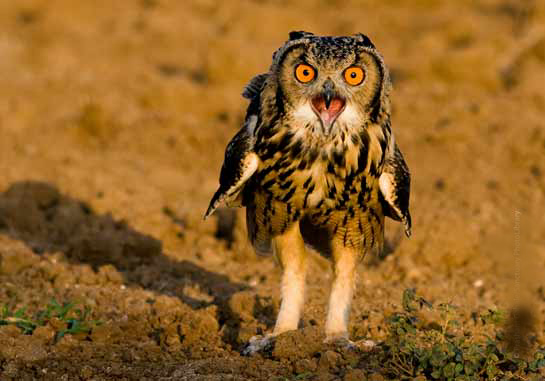 At one time the Indian Eagle Owl was considered a subspecies of the Eurasian Eagle Owl Bubo bubo, but molecular analysis has proved beyond doubt that it is a species in its own right. It does not cavity nest or build a nest, but chooses to lay its eggs in sheltered, bare areas.
At one time the Indian Eagle Owl was considered a subspecies of the Eurasian Eagle Owl Bubo bubo, but molecular analysis has proved beyond doubt that it is a species in its own right. It does not cavity nest or build a nest, but chooses to lay its eggs in sheltered, bare areas.
Buffy Fish-owl Ketupa ketupu
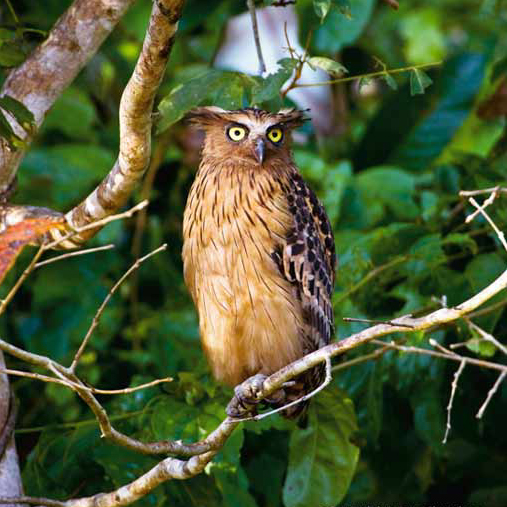
It has brilliant yellowish eyes, a white patch above the bill and distinctive ear-tufts tilted at 45 degrees. Found along waterbodies in parts of south and Southeast Asia, it primarily eats fish, frogs and crustaceans though it may also prey on small mammals and birds. It looks quite similar to the Brown Fish Owl except for its darker feathers with thick black streaks. It roosts on trees during the day and begins hunting after dusk. The sharp spicules on the underside of the toes help it to hold on to slippery fish. Interestingly, this owl is not totally silent in flight as it lacks the soft fringes found along the rear-edges of the wing feathers of most other owl species.
Forest Owlet Heteroglaux blewitti
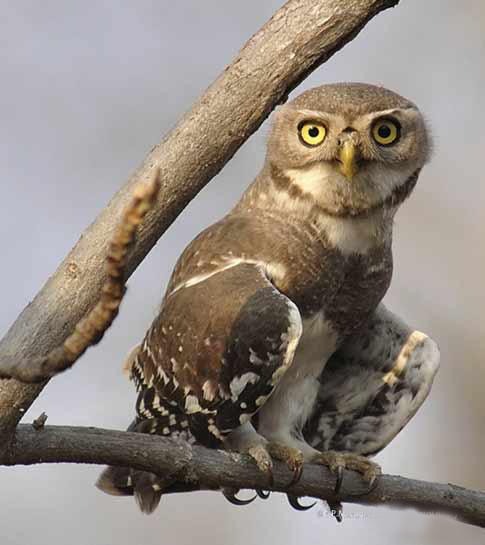
Thought to be extinct for almost 113 years, an American ornithologist Pamela Ramussen rediscovered the bird in the Satpura foothills in 1997. Since then others have located the Forest Owlet in nearby forests in southeast Madhya Pradesh and northern Maharashtra including the Melghat Tiger Reserve. There are estimated to be less than 250 birds and so it is critically endangered. The Forest Owlet is quite distinctive – it has white belly patches and prominent white markings on moustache and supercilium and its eyebrows give it a wise old man look. Its diet mainly consists of lizards, skinks and rodents though it may also prey on small birds.
Tawny Fish-owl Ketupa flavipes

A large, powerful bird, this orange-brown coloured owl also has a white patch and white eyebrows with bushy ear tufts. The soles of its feet have prickly scales and the claws are large and curved with sharp-cutting edges. It lives along the river banks in Bangladesh, Bhutan, China, India, Laos and Vietnam where it feeds on fish, crustaceans, and small reptiles and mammals.
Jungle Owlet Glaucidium radiatuam
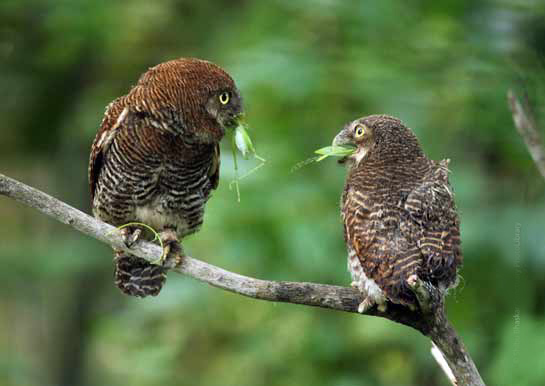
It is found in India and parts of Sri Lanka. It has a round head and little lines, like bars, across its body. This is why it is sometimes called the barred jungle owl. It lives in scrub, deciduous and moist deciduous forests where it is active mostly at dusk and dawn. Did you know that if you disturb this owl, it will freeze and pretend to be a dead tree stump? That’s pretty intelligent!
Brown Fish-owl Ketupa zeylonensis
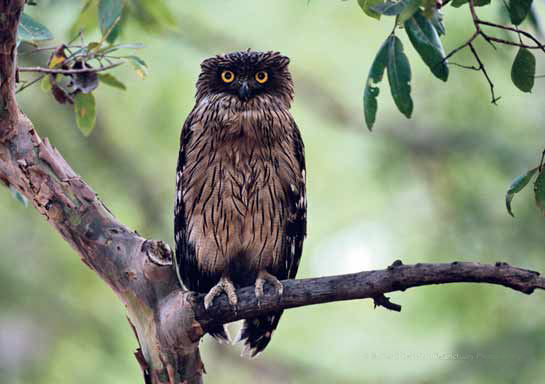
This large owl has big ear tufts and grows to around 22 inches long. The male is smaller than the female but otherwise they look similar. Both have red brown upperparts with black or dark brown streaks. The underparts are buff or white with more streaks and the throat is white. If you look closely, you will see that it has yellow irises which match its yellow feet!
Indian Scops-owl Otus bakkamoena
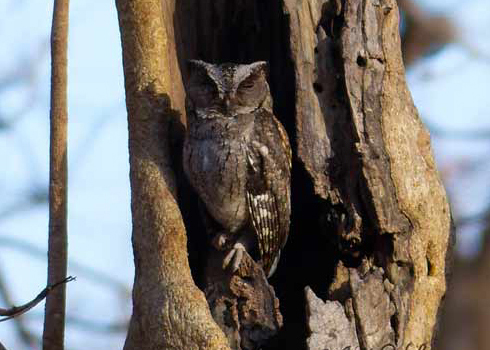
This owl lives in several countries including Bangladesh, Cambodia, China, India, Indonesia and Japan. The colour of its feathers varies according to the area it is found in. It has black, brown streaks and white patches on its body. This owl roosts in thick vegetation by day. It mainly feeds on beetles and other insects. When the owl feels threatened, it will raise its ear tuft, stand very still, close its eyes and blend into the tree.
Spotted Owlet Athene brama
